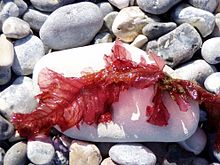Blood-red sea sorrel
| Blood-red sea sorrel | ||||||||||||
|---|---|---|---|---|---|---|---|---|---|---|---|---|

Blood-red
sea sorrel ( Delesseria sanguinea ), |
||||||||||||
| Systematics | ||||||||||||
|
||||||||||||
| Scientific name | ||||||||||||
| Delesseria sanguinea | ||||||||||||
| ( Hudson ) JV Lamouroux |

The blood- red sea sorrel ( Delesseria sanguinea ), also called blood-red sea sorrel , is a species of red algae that lives in the Atlantic . It also occurs in the North Sea near Helgoland and in the Baltic Sea .
description
The thallus of the blood-red sea sorrel is attached to the ground with a thick adhesive disc. This gives rise to a short, cartilaginous, mostly branched stalk, on which there are single or several leaf-like phylloids . They are blood-red to rose-red, narrow or broadly lanceolate, about 5 to 25 cm long and 3 to 10 cm wide, short-stalked, with a smooth, often wavy-wrinkled edge. Characteristic for the species is a strong central rib reaching to the tip with clearly visible paired side veins. The leaf surface is single-layered between the side veins.
Development cycle
The blood-red sea sorrel is perennial, with only the midribs wintering. At the end of winter, many narrow leaflets form on it, which grow into large phylloids in spring. The leaf edge then appears strongly curled in the summer months due to surface growth. From August the leaf surface degenerates again.
In winter, the reproductive organs develop on the midribs on separate male and female gametophytes . The male gametes are formed in small, colorless leaflets. On female plants, after the egg cells have been fertilized, the cystocarpia develop into narrow-lined nodules. Inside is the second generation, the tiny carposporophyte . At the end of February it releases the carpos spores from which the third generation, the tetrasporophyte, germinates. The tetraspores are also created in special leaflets.
Occurrence
The blood-red sea sorrel occurs in the northeast Atlantic from Scandinavia to the Atlantic coast of Spain, as well as in the North Sea and Baltic Sea , and occasionally in the Mediterranean . It has been proven on the Heligoland rock base and on the coasts of the western and eastern Baltic Sea.
It grows in deeper bank zones ( sublittoral ) from the low water line to a depth of about 30 meters. It inhabits rocks or shady tide pools . Occasionally it also settles epiphytically on other seaweed . It can often be found washed up on the beach in large quantities after storms.
Systematics
The first scientific description was in 1762 by William Hudson under the name Fucus sanguineus (in: Flora anglica , p. 475). Jean Vincent Félix Lamouroux separated the species in 1813 as a separate genus Delesseria , the type of which is Delesseria sanguinea .
Synonyms are Delesseria sanguinea f. filiformis Levring , Delesseria sanguinea var. lanceolata C. Agardh , Fucus sanguineus Hudson , hydrolapathum sanguineum (Hudson) Stackhouse , Sphaerococcus sanguineus (Hudson) Wahlberg and Wormskioldia sanguinea (Hudson) Spengel .
use
The blood-red sea sorrel was previously used pharmacologically to stop bleeding. It contains sulfated polysaccharides , two thirds of which consist of xylose and about a quarter of galactose and glucose , the glucose content being subject to strong fluctuations. Further monosaccharides are contained in traces . Such polymers are found in various algae such as coral moss and may have anti-inflammatory and tumor-inhibiting effects. The algae extract also inhibits enzymes involved in cell and skin aging and could be used in the cosmetics industry. The University of Kiel is conducting research projects on the Nienhagen reef in the Baltic Sea to develop a marketable product based on Delesseria sanguinea .
Individual evidence
- ↑ a b c d Wolfram Braune: Marine algae. A color guide to the common benthic green, brown and red algae of the world's oceans . Ruggell: Gantner, 2008, ISBN 978-3-906166-69-8 , pp. 490-493.
- ↑ a b c P. Kornmann, PH Sahling: Sea algae from Helgoland - Benthic green, brown and red algae. Biological Institute Helgoland, Hamburg 1983, ISSN 0017-9957 , pp. 236-237.
- ↑ a b Dirk Schories, Uwe Selig, Hendrik Schubert: Species and synonym list of the German marine macroalgae based on historical and recent records (list of species and synomes of macroalgae in German coastal waters - evaluation of historical and recent findings) . In: Rostock. Marine biologist Contribution , Issue 21, 2009, p. 69. PDF file
- ↑ Michael Guiry: The Seaweed Site: information on marine algae: Delesseria sanguinea , accessed November 3, 2015.
- ↑ Michael D. Guiry in Michael D. Guiry, GM Guiry: Delesseria sanguinea - In: Algaebase - World-wide electronic publication, National University of Ireland, Galway, accessed November 3, 2015.
- ↑ N. Grünewald, S. Alban: Optimized and standardized isolation and structural characterization of anti-inflammatory sulfated polysaccharides from the red alga Delesseria sanguinea (Hudson) Lamouroux (Ceramiales, Delesseriaceae). In: Biomacromolecules. Volume 10, Number 11, November 2009, pp. 2998-3008, doi : 10.1021 / bm900501g , PMID 19795906 .
- ↑ MR Cases, CA Stortz, AS Cerezo: Structure of the 'corallinans'-sulfated xylogalactans from Corallina officinalis. In: International journal of biological macromolecules. Volume 16, Number 2, April 1994, pp. 93-97, PMID 8011594 .
- ↑ Rich Algae Harvest , University No. 68, Christian-Albrechts-Universität zu Kiel, October 22, 2011